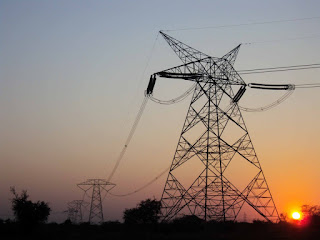High-voltage direct-current transmission lines hold the key to slashing greenhouse gases.
The $3 billion TransWest Express Transmission Project is among a handful of proposed direct-current transmission lines in the United States, and one of the furthest along in the planning process. It underscores the huge promise of these high-capacity lines to unlock the full potential of renewable energy.
Transmission isn’t sexy (see our story art above). It’s basic infrastructure. Long wires and tall towers (see How Blockchain Could Give Us a Smarter Energy Grid).
But a growing body of studies conclude that building out a nationwide network of DC transmission lines could help enable renewable sources to supplant the majority of U.S. energy generation, offering perhaps the fastest, cheapest, and most efficient way of slashing greenhouse-gas emissions.
Developing these transmission lines, however, is incredibly time-consuming and expensive. The TransWest project was first proposed in 2005, but the developers will be lucky to secure their final permits and begin moving dirt at the end of next year.
There’s no single agency in charge of overseeing or ushering along such projects, leaving companies to navigate a thicket of overlapping federal, state, county, and city jurisdictions—every one of which must sign off for a project to begin. As a result, few such transmission lines ever get built.
A macro grid
Direct current, in which electric charges constantly flow in a single direction, is an old technology. It and alternating current were the subject of one of the world’s first technology standards battles, pitting Thomas Edison against his former protégé Nikola Tesla in the “War of the Currents” starting in the 1880s (see Edison’s Revenge: The Rise of DC Power).
AC won this early war, mainly because, thanks to the development of transformers, its voltage could be cranked up for long-distance transmission and stepped down for homes and businesses.
But a series of technological improvements have substantially increased the functionality of DC, opening up new ways of designing and interconnecting the electricity grid.
...
With direct-current lines, grid operators have more options for energy sources throughout the day, allowing them to tap into, say, cheap wind two states away during times of peak demand instead of turning to nearby but more expensive natural-gas plants for a few hours. The fact that regions can depend on energy from distant states for their peak demand also means they don’t have to build as much high-cost generation locally.
The point-to-point DC transmission scenario demonstrated the highest immediate economic return in the study, which will be published in the months ahead. But the macro-grid approach offers far greater redundancy and resilience, ensuring that the grid keeps operating if any one line goes down. It also makes it possible to build out far more renewable energy generation.
“The macro grid gives you a highway to all those loads and ties all those markets together,” says Dale Osborn, transmission planning technical director at the Midcontinent Independent System Operator (MISO), which first designed the system. “You get the most efficient, lowest-cost energy possible.”
Giant batteries
A national direct-current grid could also help lower emissions to as much as 80 percent below 1990 levels within 15 years, all with commercially available technology and without increasing the costs of electricity, according to an earlier study in Nature Climate Change.
Read more at How to Get Wyoming Wind to California, and Cut 80% of U.S. Carbon Emissions

No comments:
Post a Comment